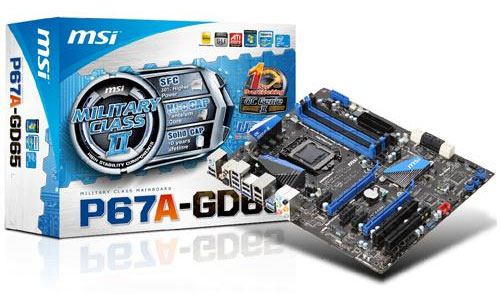MSI P67A-GD65 Motherboard Review
With the original problems of the Intel P67 platform now well and truly fixed, a Sandy Bridge set-up is once again a great recommendation for any computer enthusiast looking for a new CPU or motherboard. We all know how blisteringly fast, stupendously overclockable and extremely good value the Intel LGA1155 processors are, especially the Core i5 2500K’ and Core i7 2600K’. The K’ series of processors feature the unlocked multiplier meaning they are built for overclocking. Anybody looking forward to enjoying the wonders of these new processors also needs a motherboard to suit their needs and not break the bank. P67 or Z68 boards are exactly where the enthusiast crowd are looking.
The P67 platform brings new features like SATA 6GB/s support and an improved memory controller. Couple those features with the added in features on a large quantity of the mid range and high end boards and it makes for a very feature rich set-up!
When you look for a P67 motherboard which tick’s all of the boxes and comes in at an aggressive price, you are spoilt for choice. Today we will see how well MSI’s P67A-GD65 performs.
MSI are a company which has improved its quality and range of products exponentially in the past few years. They produce a variety of computing components ranging from graphics cards to motherboards and even to notebooks. They offer some of the best priced components for the value segments of the market and also some of the best performing components for the enthusiasts out there.
The P67A-GD65 is one of the more recent boards MSI have released. It is part of the MSI Military class’ range of components and also contains useful features like the updated OC Genie 2′ and UEFI click BIOS’. It is packed to the brim with features and comes in at a very affordable price tag of around £130. It has some stiff competition in the similarly priced P67A-UD4 from Gigabyte and the slightly more expensive P8P67 PRO from Asus though.
So does the GD65 live up to its military class advertising? Or is it just class clown? Let’s take a look…
Specifications
[TABLE=class: grid][TR][TD]Model[/TD][TD]MSI P67A-GD65 (B3)[/TD][/TR][TR][TD]CPU[/TD][TD] Supports Intel® Sandy Bridge processors in LGA1155 package[/TD][/TR][TR][TD]Chipset[/TD][TD]Intel® P67 Chipset[/TD][/TR][TR][TD]Memory[/TD][TD]1. Supports four unbuffered DIMM of 1.5 Volt DDR3 1066/1333/1600*/2133*(OC) DRAM, 32GB Max2. Supports 1GB/ 2GB/ 4GB/ 8GB DRAM size
3. Supports Dual channel mode[/TD][/TR][TR][TD]Expansion
Slots[/TD][TD]1. 2 PCI Express gen2 x16 slots
2. 3 PCI Express gen2 x1 slots
3. 2 32-bit v2.3 master PCI bus slots
4. Support 3.3v/5v PCI bus interface[/TD][/TR][TR][TD]Multi-GPU
Support[/TD][TD]ATI Crossfire and Nvidia SLI Support[/TD][/TR][TR][TD]Storage[/TD][TD]1. 4 x SATA II (3GB/S) ports from the P67 chipset
2. 2 x SATA III (6GB/S) ports from the P67 chipset
3. 2 x SATA III (6GB/S) ports from the Marvell SE9128 controller
4. 2 x eSATA II (3GB/S) ports from the JMicron® JMB362 chipset[/TD][/TR][TR][TD]LAN[/TD][TD]PCI Express LAN 10/100/1000 Fast Ethernet by Realtek 8111E[/TD][/TR][TR][TD]Audio[/TD][TD]1. Chipset integrated by Realtek® ALC892
2. Flexible 8-channel audio with jack sensing[/TD][/TR][TR][TD]IEEE 1394[/TD][TD]1. VIA® VT6308P chipset
2. Supports up to two 1394 ports. (Rear panel x1, header x1)[/TD][/TR][TR][TD]USB[/TD][TD]1. 4 USB 3.0 ports(2 by back panel, 2 by internal ports) by NEC® uPD720200F1
2. 10 USB 2.0 ports (2 mid-board, 8 at back)[/TD][/TR][TR][TD]Internal I/O Connectors[/TD][TD]- ATX 24-Pin power connector
– 8-pin ATX 12V power connector
– CPU x 1 / System x 4 FAN connectors
– CD-in connector
– Front panel audio connector
– Front panel connector
– 1 x chasis intrusion connector
– 1 x USB 2.0 connector
– 1 x USB 3.0 connector
– 4 x Serial ATAII connectors
– 4 x Serial ATAIII connectors
– 1 x IEEE1394 connector
– 1 x Clear CMOS jumper
– 1 x SPDIF-out connector
– 1 x TPM module connector
– 1 x Serial port connector
– 1 x Voltage Check Point
– 1 x Power button
– 1 x Reset button
– 1 x OC Genie button[/TD][/TR][TR][TD]Back Panel I/O Ports[/TD][TD]- 1 x PS/2 Mouse/Keyboard port
– 8 x USB 2.0 ports
– 1 x Clear CMOS button
– 1 x Coaxial SPDIF port
– 1 x Optical SPDIF port
– 1 x IEEE1394 port
– 2 x eSATA ports
– 1 x RJ45 LAN Jack
– 2 x USB 3.0 ports
– 1 x 6 in 1 audio jack[/TD][/TR][TR][TD]Exclusive
Features[/TD][TD]Military Class
– HI-C Capacitor – More Stable Tantalum Core, Higher reliability and Longer Lifespan
– Super Ferrite Choke – 30% Higher Current Capacity, whistle-free design
– Solid Capacitor – 10 Year Ultra-Long Lifetime, low ESR
OC Genie 2
– Intelligent detect hardware settings
– Automatically overclock CPU and Memory in 1 second
– Increase CPU speed up to 4.GHz
Click BIOS
– New UEFI BIOS with graphical menu
– User Friendly Mouse or Keyboard Controlled Interface
– Multi-language support[/TD][/TR][/TABLE]








